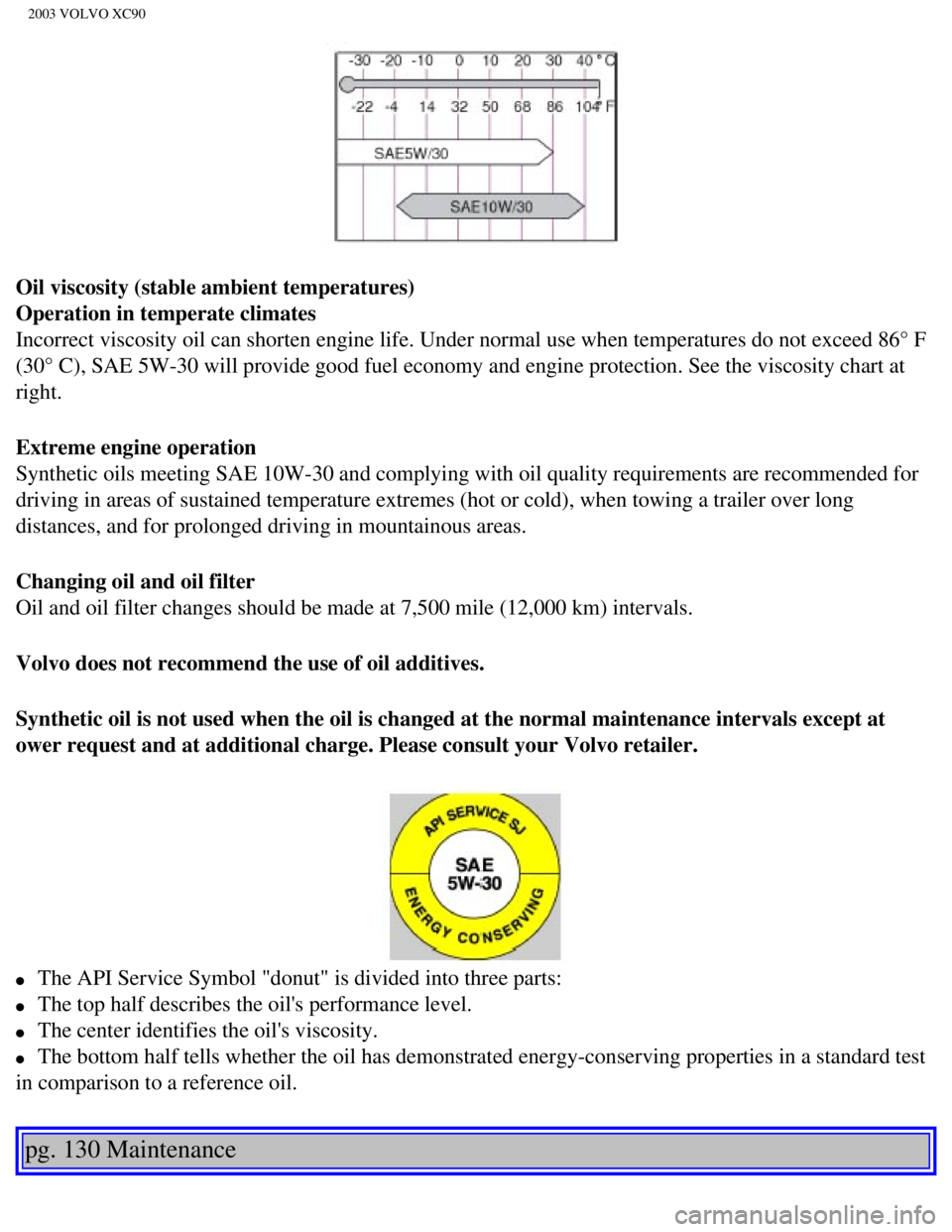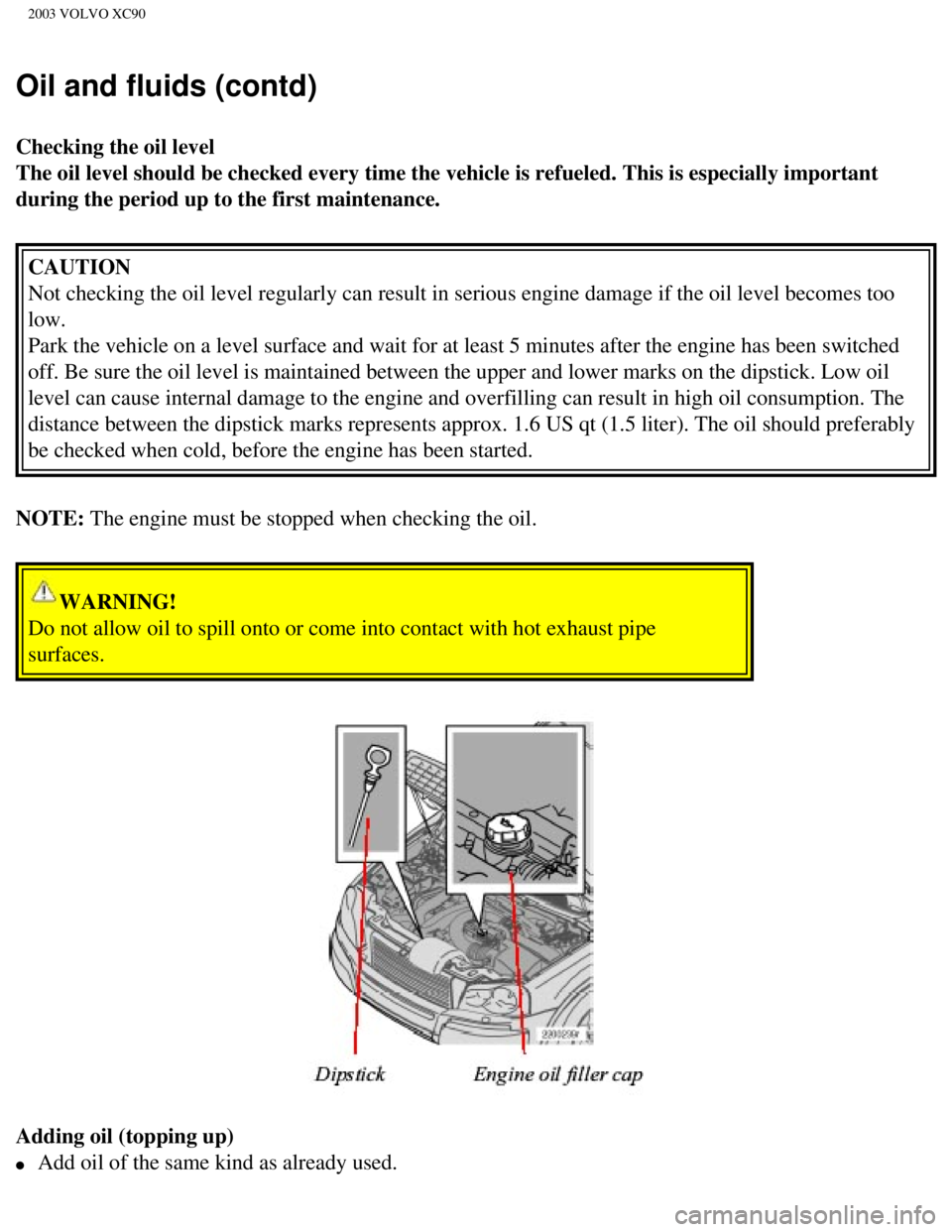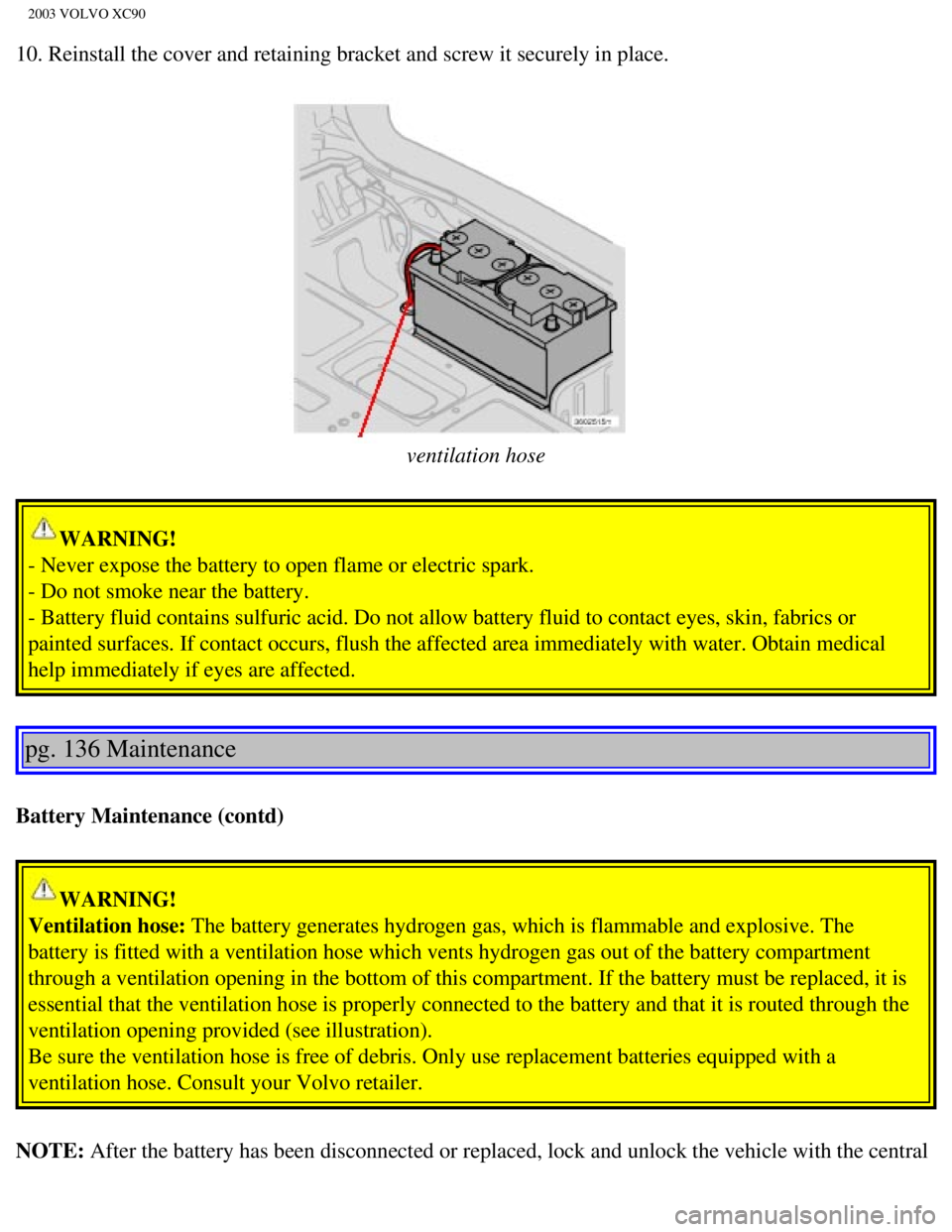Page 160 of 242

2003 VOLVO XC90
Oil viscosity (stable ambient temperatures)
Operation in temperate climates
Incorrect viscosity oil can shorten engine life. Under normal use when t\
emperatures do not exceed 86° F
(30° C), SAE 5W-30 will provide good fuel economy and engine protec\
tion. See the viscosity chart at
right.
Extreme engine operation
Synthetic oils meeting SAE 10W-30 and complying with oil quality require\
ments are recommended for
driving in areas of sustained temperature extremes (hot or cold), when\
towing a trailer over long
distances, and for prolonged driving in mountainous areas.
Changing oil and oil filter
Oil and oil filter changes should be made at 7,500 mile (12,000 km) in\
tervals.
Volvo does not recommend the use of oil additives.
Synthetic oil is not used when the oil is changed at the normal maintena\
nce intervals except at
ower request and at additional charge. Please consult your Volvo retaile\
r.
l The API Service Symbol "donut" is divided into three parts:
l The top half describes the oil's performance level.
l The center identifies the oil's viscosity.
l The bottom half tells whether the oil has demonstrated energy-conserving\
properties in a standard test
in comparison to a reference oil.
pg. 130 Maintenance
file:///K|/ownersdocs/2003/2003_XC90/03xc90_09a.htm (8 of 15)12/30/200\
6 4:19:02 PM
Page 161 of 242

2003 VOLVO XC90
Oil and fluids (contd)
Checking the oil level
The oil level should be checked every time the vehicle is refueled. This\
is especially important
during the period up to the first maintenance. CAUTION
Not checking the oil level regularly can result in serious engine damage\
if the oil level becomes too
low.
Park the vehicle on a level surface and wait for at least 5 minutes afte\
r the engine has been switched
off. Be sure the oil level is maintained between the upper and lower mar\
ks on the dipstick. Low oil
level can cause internal damage to the engine and overfilling can result\
in high oil consumption. The
distance between the dipstick marks represents approx. 1.6 US qt (1.5 l\
iter). The oil should preferably
be checked when cold, before the engine has been started.
NOTE: The engine must be stopped when checking the oil.
WARNING!
Do not allow oil to spill onto or come into contact with hot exhaust pip\
e
surfaces.
Adding oil (topping up)
l Add oil of the same kind as already used.
file:///K|/ownersdocs/2003/2003_XC90/03xc90_09a.htm (9 of 15)12/30/200\
6 4:19:02 PM
Page 162 of 242
2003 VOLVO XC90
l Capacity (including filter): 5-cylinder turbo engine - 6.1 US qt (5.8\
liters).
6-cylinder turbo engine - 7 US qt (6.7 liters)
l The oil filter should be replaced at every oil change.
pg. 131 Maintenance
Washer fluid reservoir
Washer fluid reservoir
The washer fluid reservoir is located in the engine compartment and hold\
s approx. 6.8 US qt (6.5 liters).
During cold weather, the reservoir should be filled with windshield wash\
er solvent containing antifreeze.
file:///K|/ownersdocs/2003/2003_XC90/03xc90_09a.htm (10 of 15)12/30/20\
06 4:19:02 PM
Page 168 of 242

2003 VOLVO XC90
pg. 134 Maintenance
Battery Maintenance
The battery in your vehicle is located under the floor of the cargo comp\
artment.
Driving habits and conditions, climate, the number of starts, etc. all a\
ffect the service life and function of
the battery. In order for your battery to perform satisfactorily, keep t\
he following in mind:
l Check the fluid level in each cell in the battery every 24 months or eve\
ry 15,000* miles (24,000 km),
whichever is sooner. The fluid should be at the level shown in the illus\
tration above (A)**.
l Use a screw driver to open the caps and a flashlight to inspect the leve\
l.
l If necessary, add distilled water. The level should never be above the i\
ndicator (A**).
l The fluid level should be checked if the battery has been recharged.
l After inspection, be sure the cap over each battery cell is securely in \
place.
l Check that the battery cables are correctly connected and properly tight\
ened. Route ventilation hose
through opening in floor (see
page 135)
l Never disconnect the battery when the engine is running, for example whe\
n changing the battery.
l The battery should be disconnected from the vehicle when a battery charg\
er is used directly on the
battery.
l However, if the battery is being charged via the connecting points in th\
e engine compartment (see
page 102), the battery must be connected.
* More frequently in warm climates.
** The level indicator inside the battery could be designed in various w\
ays. See illustration.
file:///K|/ownersdocs/2003/2003_XC90/03xc90_09b.htm (1 of 23)12/30/200\
6 4:19:04 PM
Page 169 of 242
2003 VOLVO XC90
pg. 135 Maintenance
file:///K|/ownersdocs/2003/2003_XC90/03xc90_09b.htm (2 of 23)12/30/200\
6 4:19:04 PM
Page 171 of 242

2003 VOLVO XC90
10. Reinstall the cover and retaining bracket and screw it securely in p\
lace.
ventilation hose
WARNING!
- Never expose the battery to open flame or electric spark.
- Do not smoke near the battery.
- Battery fluid contains sulfuric acid. Do not allow battery fluid to co\
ntact eyes, skin, fabrics or
painted surfaces. If contact occurs, flush the affected area immediately\
with water. Obtain medical
help immediately if eyes are affected.
pg. 136 Maintenance
Battery Maintenance (contd)
WARNING!
Ventilation hose: The battery generates hydrogen gas, which is flammable and explosive. T\
he
battery is fitted with a ventilation hose which vents hydrogen gas out o\
f the battery compartment
through a ventilation opening in the bottom of this compartment. If the \
battery must be replaced, it is
essential that the ventilation hose is properly connected to the battery\
and that it is routed through the
ventilation opening provided (see illustration).
Be sure the ventilation hose is free of debris. Only use replacement bat\
teries equipped with a
ventilation hose. Consult your Volvo retailer.
NOTE: After the battery has been disconnected or replaced, lock and unlock the\
vehicle with the central
file:///K|/ownersdocs/2003/2003_XC90/03xc90_09b.htm (4 of 23)12/30/200\
6 4:19:04 PM
Page 172 of 242
2003 VOLVO XC90
locking system's remote control to reactivate such features as the power\
windows, moonroof, courtesy
lighting, etc.
WARNING!
PROPOSITION 65 WARNING!
Battery posts, terminals, and related accessories contain lead and lead \
compounds, chemicals known
to the state of California to cause cancer and reproductive harm. Wash h\
ands after handling.
pg. 137 Maintenance
Bulbs
The following bulbs are used in the vehicle:
1. Low beam/high beam - 55W H7
2. Bi-Xenon headlight (option) - 35W D2R
3. Backup light - 21 W BA15
4. Brake light - 21W BA15
5. Turn signals, rear - PY21W(amber bulb)
6. Turn signals, front - H21W
7. Door step courtesy light/cargo area lighting - W5W
8. Vanity mirror - 1,2W
9. License plate lighting/parking light in headlight/side marker light, \
rear W5W
Side turn signal - W5W (amber bulb)
10. Fog lights, front - 55W H1
11. Fog light, rear - 21W BA5
file:///K|/ownersdocs/2003/2003_XC90/03xc90_09b.htm (5 of 23)12/30/200\
6 4:19:04 PM
Page 173 of 242
2003 VOLVO XC90
12. Parking lights, rear - P21/4W
l Never touch the glass of bulbs 1, 2, 3, 10 with your fingers. Grease and\
oils from your fingers
evaporate in the heat and will leave a deposit on the reflector, quickly\
damaging it.
l Bi-Xenon headlight bulbs (option) contain trace amounts of mercury. Th\
ese bulbs should always be
disposed of by an authorized Volvo retailer.
WARNING!
Bi-Xenon headlights (option) - due to the high voltage used by these h\
eadlights, these bulbs should
only be replaced by an authorized Volvo service technician.
pg. 138 Maintenance
Retaining pins
Replacing high/low beams/turn signal/parking light bulbs
The entire lamp housing must be lifted out when replacing these bulbs.
To lift out the lamp housing:
1. Switch off the ignition.
2. Open the hood.
3. Pull up the retaining pins (see the illustration above).
4. Lift out the lamp housing.
file:///K|/ownersdocs/2003/2003_XC90/03xc90_09b.htm (6 of 23)12/30/200\
6 4:19:04 PM